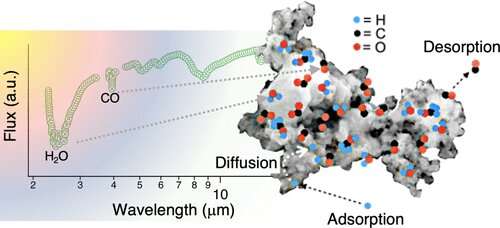New data collection puts star and planet formation in astronomers' reach

Scientists from around the world have published data that will help astronomers better understand what they see in space, and model how new stars and planets form.
The release is timely: the James Webb Space Telescope should send back its first images from space in June 2022, providing astronomers with new riddles to solve.
The data provide astronomers with the information they need to understand how interstellar ice evaporates and recondenses during the formation of stars and planets.
It is the product of over 20 years of laboratory data collection. Nineteen scientists from around the world coordinated the data collection and helped interpret the findings.
The data focuses on how interstellar ice evaporates and recondenses in space, depending on how close or far it is from a star, and the formation of snowlines where specific substances condense.
Professor Martin McCoustra, an astrochemist at Heriot-Watt University, was one of the scientists who helped produce the consensus.
For over 15 years he has been recreating deep space in his Edinburgh laboratory, using ultrahigh vacuum technology to mimic space conditions and examine the chemistry behind how stars and planets are created.
McCoustra said: "The astronomy community can now find all the data relating to thermal desorption in one place, thanks to the group effort behind this data compilation. We've also highlighted the limitations of the data to ensure it is used appropriately in models and to encourage other scientists to explore ice desorption processes.
"Our data sets values for the two parameters used to describe how quickly molecules desorb from dust grain surfaces. First, the activation energy for desorption, which tells us how strongly a chemical substance is held on a surface.
"Second, the frequency factor tells us how fast desorption would occur if there was no activation energy required.
"In space, we see snow lines just like those on hills and mountains on Earth. These tell us where specific compounds like water, carbon monoxide and carbon dioxide freeze on the space dust that surrounds young stars.
"Astronomers want to understand where these lines are and why. To do that, we need to understand how the molecules desorb when the grains are heated up.
"This will help them better understand why different types of planet form, from wet, rocky ones like Earth to a gas giant like Jupiter, and where."
The data was published as an article in the journal ACS Earth and Space Chemistry.
More information: Marco Minissale et al, Thermal Desorption of Interstellar Ices: A Review on the Controlling Parameters and Their Implications from Snowlines to Chemical Complexity, ACS Earth and Space Chemistry (2022). DOI: 10.1021/acsearthspacechem.1c00357
Provided by Heriot-Watt University





















